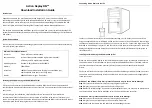tinb21e1 (2016-06)
25
4 Setup
and
Operation
4.1 Initial
Setup
Two of the most important steps for the initial setup of the gauge
are to set zero (SET VAC) and set atmosphere (SET ATM) as
described in the Programming section 4.3 below. This will en-
sure proper operation of the gauge and accurate pressure mea-
surements. The gauge is calibrated at the factory using nitrogen.
Furthermore, the gauge is also installed in a certain orientation
when calibrated at the factory. Without setting zero and atmos-
phere after the gauge is installed in your system, the gauge may
not display the expected and correct pressures. This could be
caused by the fact that you may be using a different gas than
Nitrogen such as air to setup and calibrate the gauge (most com-
monly the case) and the gauge orientation is different than the
orientation used at the factory. As such, it is very important to
perform your own initial setup and calibration by setting zero and
atmosphere with the gauge installed in your actual system.
Please note the following:
Setting zero (SET VAC):
Setting zero optimizes performance of
the gauge when operating at a low pressure range of
1.00×10
-4
Torr to 1.00×10
-3
Torr. If your minimum operating pres-
sure is higher than 1.00×10
-3
Torr, it is not normally necessary to
set zero and thus setting atmosphere should be adequate. If you
are able to evacuate your system to below 1.00×10
-4
Torr, it is
always a good practice to check and set zero if necessary. See
"SET VAC" in section 4.3.
Setting Atmosphere (SET ATM):
Setting atmosphere is the
most important step for a newly installed gauge. If you prefer to
use air to set atmosphere, vent your vacuum system chamber to
expose the gauge to the local atmospheric pressure (air) and set
atmosphere to match your known local uncorrected barometric
pressure (air). This is the reading of ambient air pressure you will
expect if you were to vent and open your vacuum chamber to the
atmosphere surrounding the outside of your chamber. At sea
level, this pressure is usually near 760 Torr.
Summary of Contents for PGE500
Page 83: ...tinb21e1 2016 06 83 Notes...


















